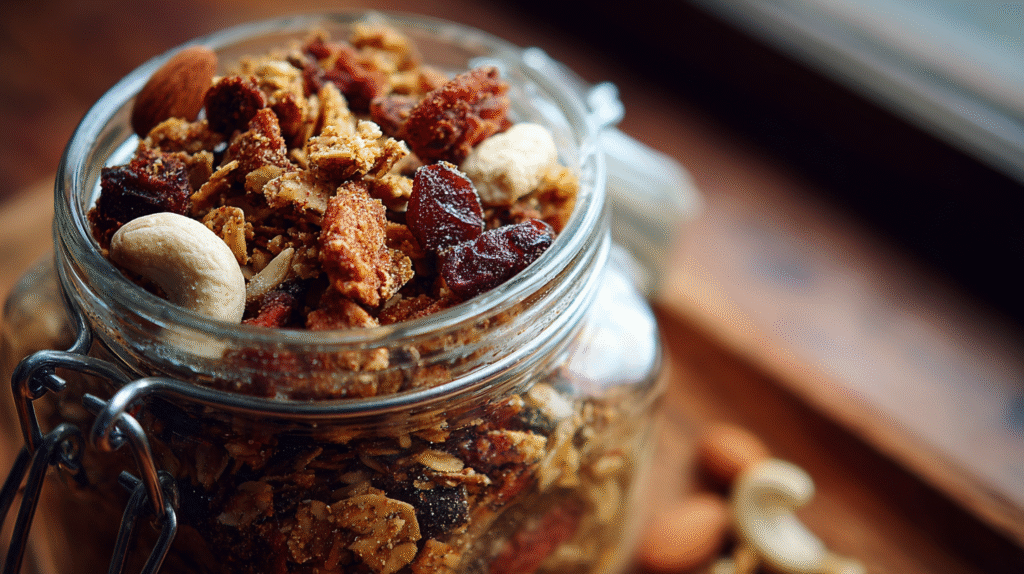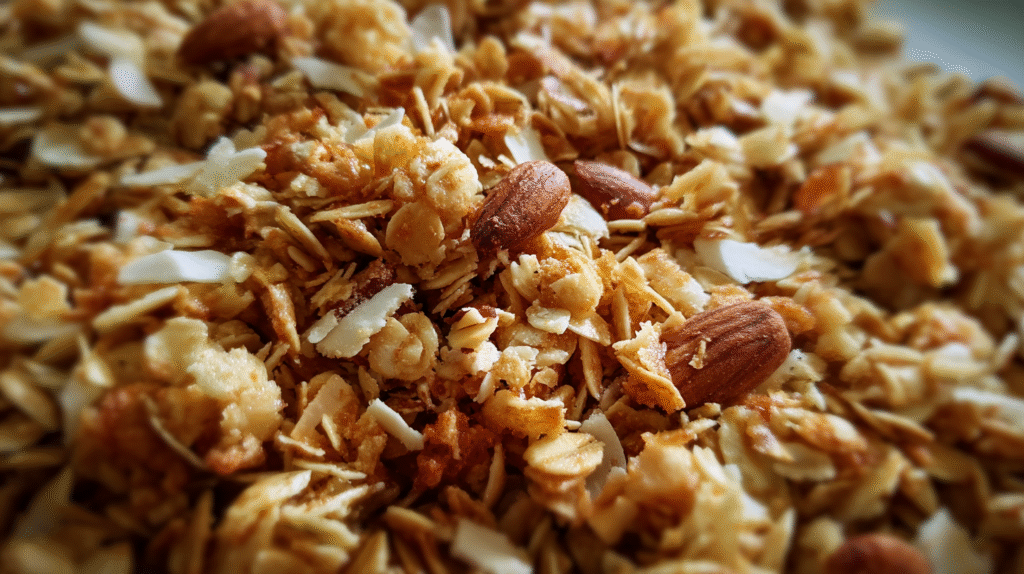Looking for a crunchy breakfast that won’t kick you out of ketosis? You’re in the right place.
Most store-bought muesli is loaded with oats, dried fruits, and hidden sugars—basically carb bombs disguised as health food. But homemade keto muesli? That’s a different story entirely.
I’ve spent months perfecting this recipe, and I’m sharing everything I’ve learned about creating a truly crispy, low-carb muesli that actually tastes good. No cardboard texture, no weird aftertaste—just wholesome crunch.

Why Make Your Own Keto Muesli?
Store-bought “keto” cereals often disappoint. They’re expensive, sometimes contain questionable ingredients, and rarely deliver on the crunch factor.
Making your own gives you complete control. You choose every ingredient, adjust sweetness to your preference, and save money in the process.
Plus, you avoid the seed oils and artificial flavors that sneak into commercial products. When you’re following keto for health reasons, ingredient quality matters.
Understanding Keto-Friendly Muesli Ingredients
Traditional muesli relies on oats—around 27g of net carbs per serving. That’s your entire daily carb allowance on strict keto.
The best low-carb base ingredients include:
Nuts form the foundation. Almonds, pecans, and walnuts provide healthy fats while keeping carbs minimal. A quarter cup of almonds has just 3g net carbs.
Seeds add variety and nutrients. Pumpkin seeds, sunflower seeds, and hemp hearts contribute protein and minerals. They also create different textures in every bite.
Coconut plays multiple roles. Unsweetened coconut flakes add natural sweetness and fiber, while coconut chips provide extra crunch. Both are low in net carbs.
My Tested Keto Muesli Recipe
This recipe makes about 8 servings. Each serving contains roughly 4-5g net carbs, depending on your specific ingredients.
Base ingredients:
- 1 cup sliced almonds
- 1 cup pecan halves, roughly chopped
- ½ cup pumpkin seeds
- ½ cup sunflower seeds
- ½ cup unsweetened coconut flakes
- ¼ cup hemp hearts
- ¼ cup chia seeds
For sweetness and binding:
- 3 tablespoons coconut oil or butter (melted)
- 2 tablespoons sugar-free maple syrup or monk fruit syrup
- 1 teaspoon vanilla extract
- ½ teaspoon cinnamon
- Pinch of salt

The Secret to Maximum Crispiness
Here’s what most recipes get wrong: they bake everything together at one temperature. That’s why you end up with some burnt pieces and some soggy ones.
The proper technique:
Preheat your oven to 300°F (150°C). Lower temperatures prevent burning and allow even toasting.
Mix your dry ingredients thoroughly in a large bowl. This ensures even coating and consistent flavor.
Warm your coconut oil, sweetener, vanilla, and spices together. Pour this over your dry mix and stir until everything’s lightly coated. You want coverage, not sogginess.
Spread the mixture on a parchment-lined baking sheet in a single layer. Crowding creates steam, which kills crispiness.
Bake for 20 minutes, then stir gently. Return to oven for another 15-20 minutes, watching closely. The muesli should turn golden brown, not dark.
The cooling trick: Let it cool completely on the baking sheet. It continues crisping as it cools. Don’t rush this step.
Flavor Variations That Work
Once you master the basic recipe, customization becomes fun.
Chocolate lover’s version: Add 2 tablespoons of unsweetened cocoa powder to the dry ingredients. Toss in some sugar-free chocolate chips after baking.
Spiced warming blend: Increase cinnamon to 1 tablespoon. Add ½ teaspoon each of ginger, nutmeg, and a pinch of cardamom.
Tropical twist: Use macadamia nuts instead of pecans. Double the coconut flakes and add unsweetened banana extract.
Savory muesli: Skip the sweetener entirely. Add rosemary, thyme, and garlic powder. Serve over Greek yogurt with everything bagel seasoning.
Storage and Shelf Life
Proper storage determines whether your muesli stays crispy or turns stale.
Use an airtight glass container or mason jar. Plastic works too, but glass prevents any odor transfer.
Store at room temperature in a dark, cool place. Properly stored, it lasts 3-4 weeks.
Avoid the refrigerator. Moisture is your enemy here. The cold environment can make your muesli lose its crunch.
If you live in humid climates, add a food-safe silica packet to your container. This absorbs excess moisture.
How to Serve Your Keto Muesli
The serving possibilities extend beyond basic cereal.
With dairy: Pour over unsweetened almond milk, coconut milk, or heavy cream diluted with water. Full-fat Greek yogurt creates a protein-rich breakfast.
As a topping: Sprinkle over keto smoothie bowls, sugar-free parfaits, or low-carb ice cream.
Straight-up snacking: Keep a small container at your desk. It satisfies midday cravings without spiking blood sugar.
In recipes: Crumble over keto cheesecake, mix into fat bombs, or use as a crust for low-carb desserts.
Nutritional Breakdown Per Serving
Understanding macros helps you fit this into your daily targets.
Each ½ cup serving provides approximately:
- Calories: 280-320
- Fat: 26-28g
- Protein: 8-10g
- Total carbs: 11-13g
- Fiber: 6-8g
- Net carbs: 4-5g
The high fat content keeps you satisfied for hours. I’ve found that ½ cup with some protein keeps me full until lunch.
The fiber supports digestive health, which matters when you’re eating keto. Many people experience constipation on low-carb diets, so this helps.
Common Mistakes to Avoid
I’ve made every error possible with this recipe. Learn from my failures.
Using wet nuts or seeds: If your ingredients aren’t completely dry, they’ll never crisp up. Toast them lightly first if you’re unsure.
Too much liquid sweetener: More isn’t better here. Excess sweetener creates sticky clumps instead of crispy clusters.
Opening the oven constantly: Every time you check, you release heat and add moisture. Trust the process.
Not stirring halfway through: The edges cook faster than the center. One good stir ensures even toasting.
Storing while warm: This traps steam and creates sogginess. Patience pays off.
Cost Comparison: Homemade vs. Store-Bought
Let’s talk money because keto eating isn’t always budget-friendly.
Commercial keto granola or muesli costs $10-15 for 8-10 servings. That’s roughly $1.25-1.50 per serving.
Making this recipe costs approximately $12-15 for ingredients, yielding 8 servings. That’s $1.50-1.90 per serving initially.
But here’s the key: you’ll have leftover ingredients for multiple batches. Your second batch drops to about $0.75-1.00 per serving.
Buy nuts and seeds in bulk from warehouse stores. The per-pound price drops significantly.
Adapting for Different Dietary Needs
Keto overlaps with other dietary approaches. Here’s how to adjust.
Nut-free version: Replace almonds and pecans with more seeds. Add sunflower seed butter for binding. Use coconut chips for bulk.
Paleo keto: Skip the monk fruit. Use raw honey very sparingly (⅛ teaspoon per serving adds minimal carbs). Choose paleo-approved sweeteners.
Dairy-free: This recipe is already dairy-free if you use coconut oil. Serve with coconut yogurt or nut milk.
Low-FODMAP keto: Swap out almonds for macadamias. Use pumpkin seeds and sunflower seeds. Skip any dried fruit additions.
Troubleshooting Common Issues
Even with perfect instructions, questions arise.
Muesli turned out soft: Your oven temperature was likely too low, or you didn’t bake long enough. Return it to a 325°F oven for 10 more minutes.
Some pieces burned: Temperature too high or ingredients spread unevenly. Lower temp next time and ensure single-layer spreading.
Lacks sweetness: Keto palates vary. Add a bit of powdered erythritol or monk fruit after baking. Toss to coat.
Too oily: You used too much fat. Reduce coconut oil to 2 tablespoons next batch.
Doesn’t cluster: This recipe creates mostly loose muesli. For clusters, increase the coconut oil to 4 tablespoons and add one egg white.
The Science Behind Keto Muesli
Understanding why this works helps you innovate.
Traditional muesli relies on grain starches that bind and crisp during baking. Without grains, we need different chemistry.
Nuts and seeds contain natural oils. Heat activates these oils, creating crispy textures as moisture evaporates.
The small amount of coconut oil acts as both a binder and heat conductor. It helps distribute temperature evenly across all ingredients.
Low oven temperatures allow slow moisture removal without burning. High heat creates a crispy exterior but leaves interiors soft.
Fiber from chia and hemp absorbs excess moisture. This prevents sogginess while adding nutritional value.
Making Large Batches for Meal Prep
Batch preparation saves time on busy mornings.
Double or triple the recipe easily. Just ensure you use multiple baking sheets. Overcrowding prevents proper crisping.
The recipe scales perfectly up to 4x. Beyond that, mixing becomes challenging, and you’ll need commercial-size equipment.
Store large batches in multiple containers. This way, you only open one at a time, keeping the rest fresh.
Consider making different flavors in one baking session. Mix the base, then divide and add different spices to each portion.
Label containers with the date and flavor. After making several varieties, they can look similar.
Comparing to Traditional Breakfast Options
Let’s put this in perspective against common breakfast choices.
A bowl of regular muesli with milk contains 45-60g of carbs. That’s 10-12x more than keto muesli.
Standard granola with yogurt provides 40-50g of carbs, plus added sugars that spike blood glucose.
Even “healthy” options like oatmeal deliver 30-40g of carbs per serving.
Keto muesli offers the familiar breakfast experience without the metabolic disruption. You get crunch, sweetness, and satisfaction at a fraction of the carbs.
The blood sugar stability this provides matters beyond just ketosis. You avoid the mid-morning energy crash that follows high-carb breakfasts.
Frequently Asked Questions
Can I use this muesli if I’m not on keto?
Absolutely. Low-carb doesn’t mean only for keto dieters. Anyone looking to reduce sugar and refined carbs benefits from this recipe. It’s nutrient-dense and filling.
How many carbs can I have and stay in ketosis?
Most people maintain ketosis at 20-50g net carbs daily. This muesli at 4-5g per serving fits easily into that range. Individual tolerance varies based on activity level and metabolism.
Do I need to soak the nuts first?
Not necessary for this recipe. Soaking reduces anti-nutrients but also adds moisture, which works against crispiness. If you prefer soaked nuts for digestion, dry them thoroughly in a low oven first.
Can I add protein powder to this?
Yes, but timing matters. Add 2-3 tablespoons of unflavored protein powder to the dry mix. Flavored protein may burn during baking. Alternatively, sprinkle it on after baking.
Will this break my fast?
This contains calories and will technically break a fast. If you’re doing intermittent fasting, save it for your eating window. Some people use it as their first meal to break their fast gently.
Is this suitable for kids?
Kids can eat keto muesli, but most children need more carbs than strict keto allows. Consider this an occasional treat rather than a daily breakfast for growing children unless under medical supervision for epilepsy or other conditions.
Can I make this completely sugar-free?
The recipe is already sugar-free using alternative sweeteners. If you want to skip sweeteners entirely, you can. The natural flavors from vanilla, cinnamon, and toasted nuts provide plenty of taste.
Why did my muesli turn into one big clump?
Too much liquid sweetener or coconut oil creates a granola-like cluster instead of loose muesli. This isn’t necessarily bad—you’ve just made keto granola! Break it apart once cooled.
Conclusion
Making your own low-carb keto muesli transforms breakfast from a compromise into something you actually look forward to eating.
The crispy texture, customizable flavors, and simple ingredient list make this recipe a keeper. You’ll save money while controlling exactly what goes into your body.
Start with the basic recipe, master the technique, then experiment with your favorite flavor combinations. Your morning routine deserves better than soggy cereal or boring eggs.
The best part? Once you taste truly crispy homemade keto muesli, the store-bought versions won’t tempt you anymore. You’ve got this.
